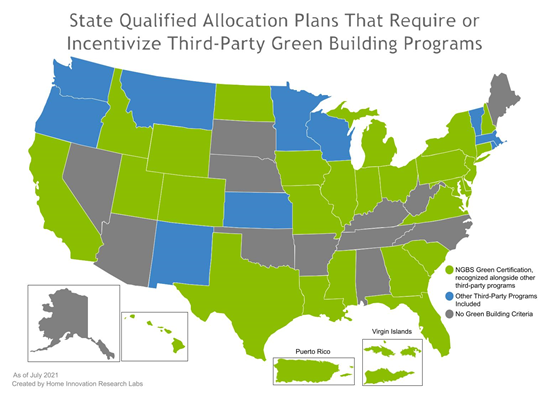

In my Quick QAP Recaps, I identify opportunities for NGBS Green Partners to advocate for third-party certified, green, affordable housing and share updates on our green advocacy efforts. In this post, I went a little more in-depth to provide a broad view of QAP green building criteria across the country and their references to NGBS Green certification.
State Qualified Allocation Plans (QAPs) specify a state agency’s allocation of federal Low-Income Housing Tax Credits (LIHTC). To encourage the development of residences that support their sustainability, resilience, and healthy housing goals, states can provide federal housing tax credits to developers that build green certified housing. Comprehensive green building programs help to ensure that projects funded by housing credits will not only create new housing opportunities, but also ensure that people living in affordable housing can live healthier, spend less money on utilities, and have more opportunities with access to transportation, better quality food, and health care.
Most state QAPs recognize the importance of third-party green building programs. Thirty-five state and local (i.e., New York City, District of Columbia, Puerto Rico, and U.S. Virgin Islands) QAPs specify third-party green building programs, either as a mandatory requirement or incentive. This means that in nearly every region of the country, affordable housing development is constructed to a green building program.
Most state QAPs offer developers choices among green building rating systems. The NGBS is typically included alongside other rigorous and credible green building programs, including Enterprise Green Communities and LEED. Twenty-nine states reference the NGBS specifically, in combination with other credible third-party programs. Most others recognize Enterprise Green Communities and LEED; some reference a specialized version of Enterprise Green Communities or their own statewide program.

Home Innovation advocates for recognition of the ICC-700 National Green Building Standard (NGBS) in QAPs because it is comprehensive, cost-effective, and well-suited for affordable housing development. NGBS compliance provides consistency across the country. The U.S. Department of Housing and Urban Development (HUD) recognizes NGBS Green certification for many of their programs, including their mortgage insurance premium (MIP) reduction for green certified properties. Fannie Mae and Freddie Mac also recognize NGBS Green certification for their financing incentives. Many institutional and private investors also prioritize their investments in buildings that have earned a third-party green certification, such as NGBS Green. Green building certifications serve as an important tool for investors to ensure that funded properties offer long-term value with lower utility costs, reduced maintenance, and better resident retention.
Requirement vs. incentive: states are equally split on their approach. QAPs include both threshold requirements that are mandatory for funded projects, as well as competitive points, which are optional features but can make a project more competitive for funding. When green building was emerging, many states first adopted green building criteria as a competitive element. As green building has grown in acceptance and familiarity among trade professionals, many states have transitioned green building to be a threshold requirement. Of the states that include green building programs, just over half (51%) require third-party green building programs, and the remainder offer competitive points for green building compliance or certification.
Most QAPs apply the same criteria for both new construction and renovation. The vast majority of states (80%) that reference green building programs apply the criteria to both new construction and renovation projects. With a few exceptions, the QAPs do not apply different expectations or points based on the project type. While this may seem like a positive thing, the lack of specificity reveals that the affordable housing staff may not fully understand the unique challenges of building rehabilitations and the landscape of green building options that exist for renovation. When advocating for green certified affordable housing, we recommend that NGBS Green Partners be as specific as possible and include recommendations for both new construction and renovation.
Six states—Florida, Indiana, Louisiana, Missouri, Puerto Rico, and South Carolina—reference third-party green building programs for new construction only. These states either implement a prescriptive checklist or do not include green building criteria for rehab.
Visit www.HomeInnovation.com/NGBSGreenIncentives to learn more. Home Innovation maintains a list of all known mandates and incentives for NGBS Green certification. If your state includes green building criteria, it should be included on our list; if there are programs or incentives that you know of that are not included, please get in touch and let me know! We are happy to provide resources and guidance for any local advocacy efforts.
***